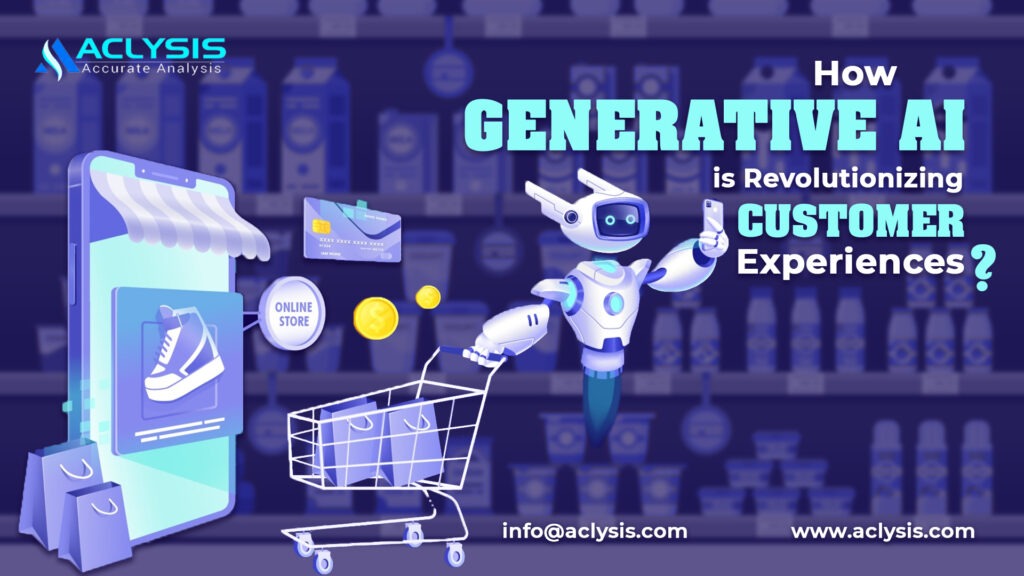By Aclysis

Introduction
In today’s digital age, customer experience has become a critical battleground for businesses. Consumers expect personalized, seamless, and engaging interactions with brands across various touchpoints. To meet these evolving expectations, companies are turning to cutting-edge technologies, with generative artificial intelligence (AI) leading the charge. This article explores how generative AI is revolutionizing customer experiences and reshaping the way businesses interact with their clientele.
Understanding Generative AI
Generative AI, a subset of artificial intelligence, involves using algorithms to generate content or data that is not explicitly programmed. It can create everything from text and images to music and videos. Unlike traditional AI systems, which rely on pre-defined rules and structured data, generative AI has the ability to produce novel and creative content.
The Role of Generative AI in Customer Experience
Personalized Content Creation:
Generative AI can analyze vast amounts of customer data to create personalized content. Whether it’s generating tailored product recommendations, writing personalized email marketing messages, or even designing customized user interfaces, generative AI can ensure that each customer interaction feels unique.
Chatbots and Virtual Assistants:
Chatbots powered by generative AI have evolved from basic rule-based systems to sophisticated conversational agents. They can understand natural language, answer complex queries, and provide personalized assistance. Virtual assistants like Siri and Google Assistant are excellent examples of generative AI enhancing customer experiences.
Content Generation:
Content is king in the digital world, and generative AI can generate high-quality content at scale. This includes blog posts, product descriptions, and social media updates, saving businesses time and resources while maintaining a consistent and engaging online presence.
Predictive Analytics:
Generative AI can predict customer behavior and preferences by analyzing historical data. This allows businesses to proactively address customer needs, reduce churn, and optimize marketing strategies.
Visual Content Enhancement:
Generative AI can improve the quality of visual content by upscaling images, removing noise, and enhancing colors. This ensures that customers have a visually appealing experience, whether they’re browsing products online or viewing user-generated content on social media.
Benefits of Generative AI for Customer Experience
Enhanced Personalization:
Generative AI helps businesses tailor their interactions with customers, creating a more personalized and engaging experience. This leads to higher customer satisfaction and loyalty.
Cost Efficiency:
Automation through generative AI reduces the need for manual content creation and customer support, saving businesses time and resources.
Improved Customer Insights:
By analyzing vast amounts of data, generative AI provides valuable insights into customer behavior, enabling businesses to make data-driven decisions.
24/7 Availability:
Chatbots and virtual assistants powered by generative AI are available round the clock, ensuring that customers can get assistance whenever they need it.
Scalability:
Generative AI can scale to handle a large volume of customer interactions, making it suitable for businesses of all sizes.
Challenges and Ethical Considerations
While generative AI holds great promise for customer experiences, there are challenges and ethical considerations to address. These include concerns about data privacy, algorithmic biases, and the potential for AI-generated content to deceive or manipulate users. It’s crucial for businesses to implement responsible AI practices and transparency in their AI-powered customer interactions.
Conclusion
Generative AI is transforming customer experiences by enabling businesses to provide personalized, efficient, and engaging interactions across various channels. As technology continues to advance, the role of generative AI in shaping customer experiences will only grow. To stay competitive in today’s market, businesses must embrace this technology responsibly, balancing the benefits of enhanced customer experiences with the ethical considerations it presents. In doing so, they can create lasting customer relationships and drive business success in the digital era.
